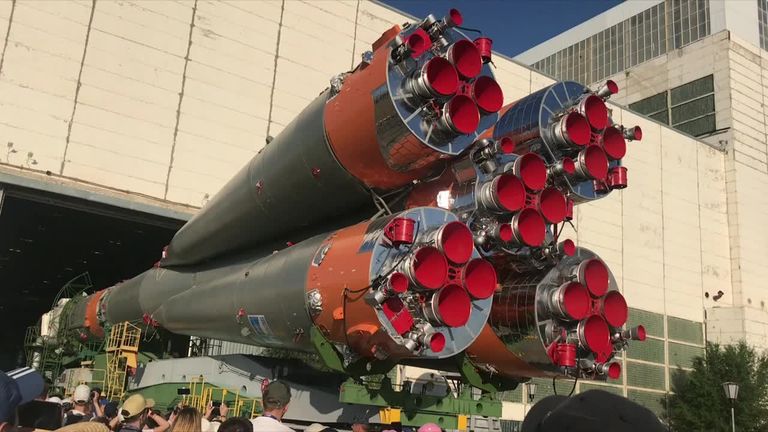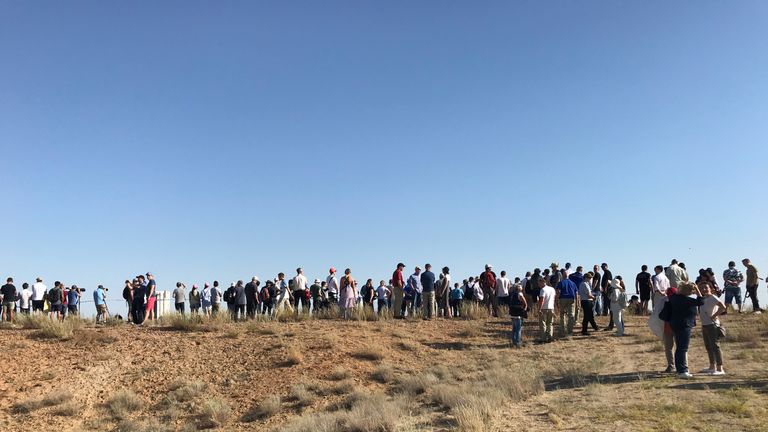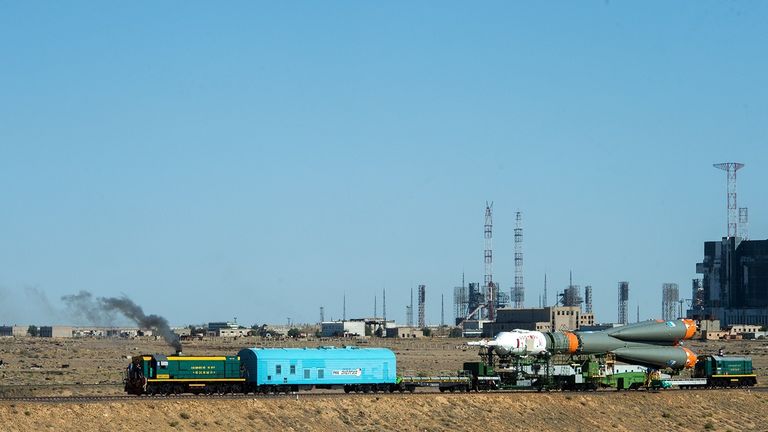Excitement as Soyuz rocket set for launch on moon landing anniversary
As the world remembers 50 years since man walked on the moon, Sky News witnesses a rocket being prepared for space.
Thursday 18 July 2019 13:59, UK
The early bird catches the rocket, so alarms were set for 3.30am and a convoy of coaches set off from the city of Baikonur in Kazakhstan before sunrise.
We travelled for close to an hour though flat countryside, not seeing a house or a person for miles. Truth is, this is good territory for a rocket launch given much of the body of the craft burns up or falls away after take-off. No point taking risks over populated areas.
As we decamped from our coaches it was clear that it wasn't just journalists around us. Tourists were pouring out of buses with cameras, selfie sticks and suncream in tow.
We were guided towards a track leading out from a big warehouse and when the door was pulled back and what was inside starting moving the woman beside me told me she was trembling. She showed me her hands which were indeed acting as she had described.
What caused this physical reaction in Anne, a tourist who had travelled from New Zealand, was the sight of a rocket passing at almost touching distance before our eyes. A Soyuz craft which in two days (barring any mishap) will be blasting off from the base for the International Space Station.
Anne tells me this is a once-in-a-lifetime trip, made all the more exciting as it's the 50th anniversary of the moon landing. Space, she says, has always fascinated her.
The rocket - with a capsule attached for its human contents - was indeed impressive, not least because looking at it, it is hard to imagine anyone would be happy to get in and head off.
But three men will be occupants heading skywards on Saturday night. An American, an Italian (astronauts) and a Russian (cosmonaut). It'll take them around six hours to get to their destination and they'll spend around a hundred days up there conducting experiments and research.
We were bussed to the next location to meet the Soyuz rocket on its train-track journey across the base, which is rented by Russia from Kazakhstan. The site is operated by the Russian space agency Roscosmos. The rocket passed us very slowly, helicopter over head, and cameramen and tourists positioned to get the best shots.
Then three people were brought to talk to us. They were the "second team" - or what you might call the understudies - who will take the place of one or more of those destined for a seat in the capsule if there is any problem.
We asked them about Donald Trump's plans to have Americans walking on the moon again by 2024 and whether Russia has similar plans. The American sounded rather more optimistic than the Russian.
After that, it was wheels-up for us to head to the launchpad. A giant structure like a cupped hand awaited the arrival of its latest occupant. There was a familiarity about what we were looking at. We've all seen launches on television and maybe that was why there was something almost film-like seeing it up close.
It took careful manoeuvring to get the rocket into position, ready for Saturday night's launch. And then slowly, very slowly, it was raised upright. Engineers and mechanics moved in immediately to start the checks and preps for launch night.
Around us were spokespeople from NASA, the European Space Agency and Roscosmos, reflecting the collaborative nature of work on the International Space Station which has been receiving an international mixture of men and women in spacesuits for the last two decades.
This is the same place Briton Tim Peake left from for the ISS in 2015.
Tomorrow we will meet the men destined to be the next residents of the ISS and will talk to them from behind glass as they are in quarantine.
One of them came close to death on a previous mission when his helmet leaked during a spacewalk. Someone will probably ask why he's going up again.






